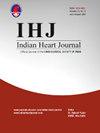既往冠状动脉旁路移植患者经皮冠状动脉介入治疗的长期疗效--回顾性经验。
IF 1.4
Q3 CARDIAC & CARDIOVASCULAR SYSTEMS
引用次数: 0
摘要
目的评估曾接受过冠状动脉搭桥术(CABG)的患者接受经皮冠状动脉介入治疗(PCI)的长期临床效果:本研究回顾性纳入了 219 名曾接受过 CABG 并在三级医疗中心接受了 PCI 治疗的患者。结果:约66.6%的患者接受了PCI治疗:结果:约66.6%的患者在原生血管接受治疗,24.2%在移植物血管接受治疗。总共植入了360个支架[83.3%为药物洗脱支架(DES),16.6%为裸金属支架(BMS)]。糖尿病(P=0.03)、LVEF50岁(P=0.04)、支架类型[BMS(P=0.03)和DES(P结论:与移植物血管PCI相比,原生血管PCI具有更好的临床疗效,对于有CABG病史的患者来说,DES也是首选。本文章由计算机程序翻译,如有差异,请以英文原文为准。
Long-term outcomes of percutaneous coronary intervention in patients with prior coronary artery bypass graft - A retrospective experience
Objective
To evaluate the long-term clinical outcomes of percutaneous coronary intervention (PCI) in patients who had previously undergone coronary artery bypass grafting (CABG).
Method
A total of 219 patients who had a history of CABG and underwent PCI at tertiary care centre were retrospectively enrolled in this study. Clinical endpoints such as major adverse cardiac events (MACE; cardiac death, non-fatal myocardial infarction [MI], and target vessel revascularization), any death, cardiac death, MI, target vessel revascularization (TVR), and target lesion revascularisation (TLR) were reported at long-term follow-up.
Results
About 66.6 % patients were treated on the native vessel, and 24.2 % on grafts vessel. In all, 360 stents [83.3 % drug-eluting stent (DES) and 16.6 % bare metal stent (BMS)] were implanted. Diabetes mellitus (p = 0.03), LVEF<55 % for PCI (p = 0.04), stent type [BMS (p < 0.001) and DES (p < 0.001)] and chronic kidney disease [(CKD) p < 0.01] were appeared to be the significant predictors of mortality. Age at CABG>50 years (p = 0.04), stent type [BMS (p = 0.03) and DES (p < 0.01)] and CKD (p < 0.01) as independent predictors for MACE. Higher event rate was reported in graft-vessel PCI group as compared to native-vessel PCI group: ISR (p < 0.01), TLR (p = 0.01), mortality (p = 0.04), MACE (p < 0.01) and MI (p = 0.05). Mortality (p < 0.001), MACE (p < 0.001) and MI (p < 0.001) were significantly lower in DES vs. BMS groups.
Conclusion
Native-vessel PCI was associated with better clinical outcomes than graft-vessel PCI that also with the use of DES as the first choice in patients with a history of CABG.
求助全文
通过发布文献求助,成功后即可免费获取论文全文。
去求助
来源期刊

Indian heart journal
CARDIAC & CARDIOVASCULAR SYSTEMS-
CiteScore
2.60
自引率
6.70%
发文量
82
审稿时长
52 days
期刊介绍:
Indian Heart Journal (IHJ) is the official peer-reviewed open access journal of Cardiological Society of India and accepts articles for publication from across the globe. The journal aims to promote high quality research and serve as a platform for dissemination of scientific information in cardiology with particular focus on South Asia. The journal aims to publish cutting edge research in the field of clinical as well as non-clinical cardiology - including cardiovascular medicine and surgery. Some of the topics covered are Heart Failure, Coronary Artery Disease, Hypertension, Interventional Cardiology, Cardiac Surgery, Valvular Heart Disease, Pulmonary Hypertension and Infective Endocarditis. IHJ open access invites original research articles, research briefs, perspective, case reports, case vignette, cardiovascular images, cardiovascular graphics, research letters, correspondence, reader forum, and interesting photographs, for publication. IHJ open access also publishes theme-based special issues and abstracts of papers presented at the annual conference of the Cardiological Society of India.
 求助内容:
求助内容: 应助结果提醒方式:
应助结果提醒方式:


